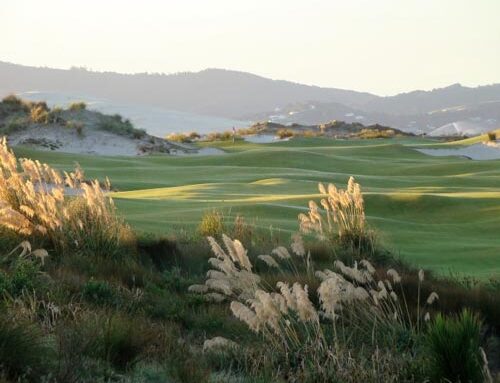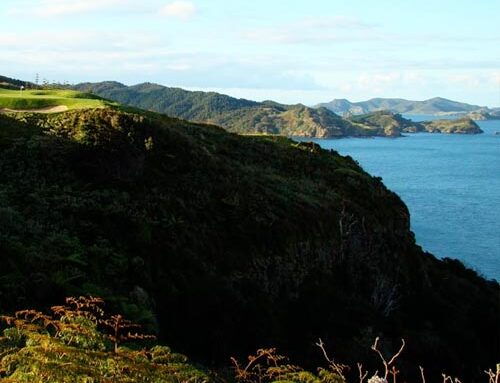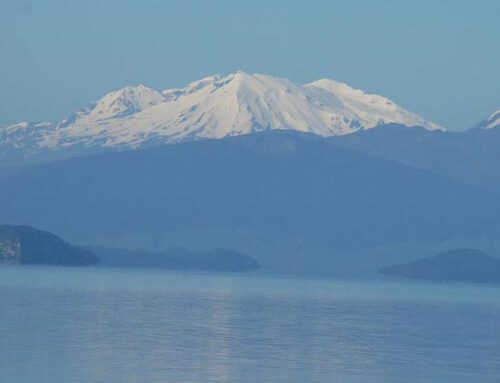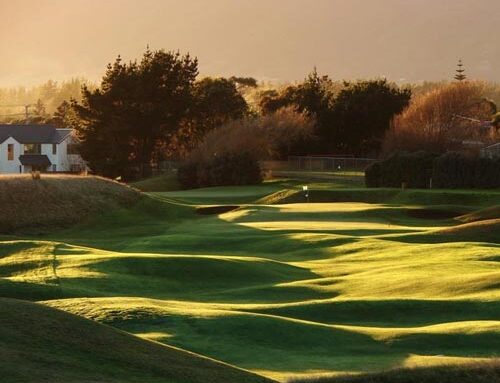Cape Kidnappers
Te Awanga, New Zealand
Golf Course Manager: Steve Marsden
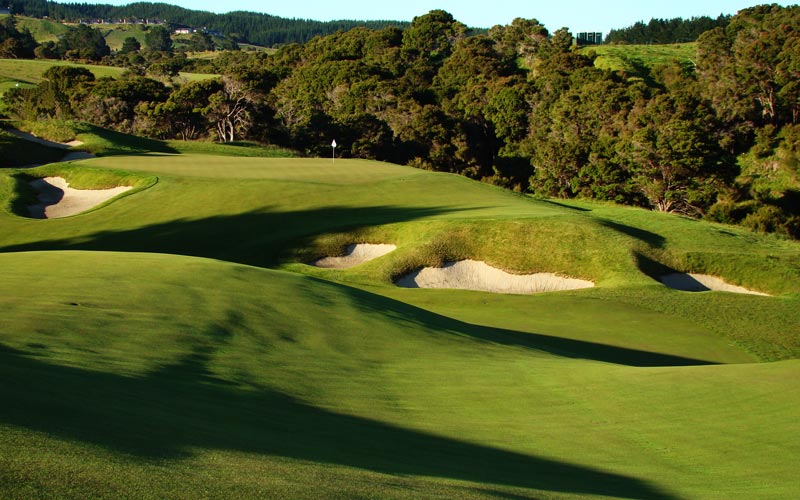
Julian Robertson’s day did not start well on June 4th, 2001. Having flown across country to Bandon, Oregon with his son Alex, he had just been informed that their scheduled second round at Bandon Dunes had been changed. They were now slated to play a golf course that had been open for only two days named Pacific Dunes. Not in the least happy, Mr. Robertson was finally convinced to give the new course a chance. Much to their surprise, both Mr. Robertson and Alex preferred Pacific Dunes over Bandon Dunes and indeed, to this day, Mr. Robertson describes Pacific Dunes as the most fun course he had played to that point. As a direct result of the impression that Tom Doak‘s work at Pacific Dunes made on him, Mr. Robertson invited Tom Doak to come see 5,000 acres that he had initially acquired on the southeast coast of the North Island of New Zealand, just south of the art deco town of Napier in the wine region of New Zealand. Despite the inauspicious start that day at Bandon, a new golf course by Tom Doak would open in New Zealand within three years that equaled the magnitude of the country’s charm and allure.
Tom Doak‘s initial visit was scheduled for November, 2001, two months after an event of monumental sadness in New York City and Washington D.C. In fact, Tom Doak missed his connection from Mexico through to Auckland as all the Styrofoam boxes with fish had to opened and inspected for bombs. Eventually, Tom Doak made it and his first introduction to the property was via helicopter from the Napier airport (funnily enough, when he left the property that evening via a single lane dirt road that wound around for five miles(!), he had reservations as to how they could even get construction equipment up to the site).
Despite the massive amount of land acquired by Mr. Robertson, there were essentially two parcels that best lent themselves to golf. One was down in a valley and the other was on higher ground with strips of land separated by deep valleys with a cliff line that soared 550 feet up from the crashing Pacific Ocean below. Clearly, the second site was the more dramatic but of course, dramatic and good golf don’t necessarily go together, as golf in Hawaii has proved for years. Tom Doak was to have everything at his disposal to build a true world class course and so the question became: could Tom Doak create eighteen consecutive holes of a caliber that would compel golfers to travel 6,000 plus miles to play them?

This view from near beach level captures the true character and grandeur of the cliffline with which Doak was given to work.
By his fourth visit in July, 2002, Tom Doak had two primary routings. One had several holes that headed off on a perpendicular angle after today’s third hole but Mr. Robertson was more captivated by the routing that went out on the finger of land where today’s fifteenth hole now occupies. Mr. Robertson urged for the cliff line to be incorporated whenever possible and that led to two of the game’s great locations, namely the green of the fifteenth pushed up the very edge and the creation of the sixteenth tee. In addition, this routing met a key mandate from Mr. Robertson and that was that the course be walkable. As Mr. Robertson appreciates, there is no such thing as a great golf course that isn’t walkable and one of Tom Doak‘s proudest accomplishments with the overall design is just how well they delivered on this point.
With the routing agreed upon, work commenced in September, 2002 with Bruce Hepner, the lead associate, moving to New Zealand for nine months. According to Hepner, one important aspect of the project was that ‘we tried to integrate the golf in with the sheep station. We wanted to respect what the property was really used for. I spent a lot of time with the station shepherd making sure we disturbed the operation as little as possible. One of our favorite times to play golf was when the lambs were out in the paddocks. Hearing the random lamb cry in the middle of a back swing usually cracked up the group.’
Tom Doak‘s lay of the land approach has helped see golf course architecture enter into a second Golden Age of golf design. However, as owner, Mr. Robertson appreciates Tom Doak‘s approach for another reason. As compared to his other course at Kauri Cliffs, Cape Kidnappers was less expensive to build and it costs approximately half as much to maintain on an annual basis, despite the fact that Cape Kidnappers features some of the widest playing areas in the game.
Of course, given that the scenery steals the show at Cape Kidnappers, many people never focus on the architecture itself. In particular, the greens taken as a set are as good as any that Tom Doak has built. Ironically, the greens that influenced him the most here are the ones found at Garden City Golf Club. Set across the Hempstead Plain on Long Island, the properties of Garden City and Cape Kidnappers could not possibly be more diverse but Garden City’s greens are famous for following the natural tilt of the ground upon which they rest. Tom Doak is intimately familiar with them having consulted at Garden City for over fifteen years, so it is no surprise that some of their best playing features are found within some of the finest greens at Cape Kidnappers. Better still, the greens slope in every manner possible at Cape Kidnappers. or example, the left to right cant of the second green is followed by the right to left tilt at the third. The front to back slope at the twelfth and fifteenth provides fabulous diversity to the ones that slope in a traditional back to front manner. As highlighted at the ninth and eighteenth, the golfer is sometimes best served to use the high ground above the putting surfaces for working his approach shot in close. All told, the range of questions posed by the green complexes is second to none.

The cliffside holes were always going to take care of themselves but the nearly unmatched top to bottom strength of the holes at Cape Kidnappers is based on how well the inland holes turned out as we see below, starting right with a superlative first hole.
Holes to Note
First hole, 440 yards, First; The golfer has likely come a great distance to play Cape Kidnappers and when he stands on the first tee and looks down the fairway, the ocean is to his back! How can this be? How can he possibly be happy to head inland? Tom Doak realized this and always felt the keenest pressure to come through with great design features at the first through third holes. After that, the routing and holes get into the landscape that makes Cape Kidnappers unique. As for the first, Tom Doak employed to great effect a favorite design feature from his mentor Pete Dye: a hole with switchback shot requirements.

A switchback hole ideally calls for one shape shot on the tee ball and another on the approach. As that relates to the opener at Cape Kidnapper, a power fade off the tee is the model start on this dogleg right whereas …
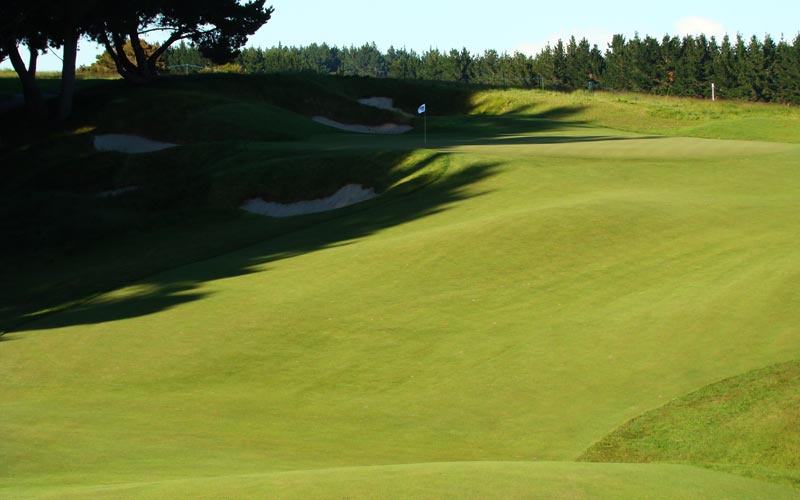
Second hole, 545 yards, Sheds; The potential of Tom Doak‘s minimalist architecture is only fully realized when his designs are presented in a fast and firm manner. Unfortunately, how his courses are ultimately presented has been an issue since going out on his own in 1988. The quality of his design work at High Pointe has been undermined, Apache Stronghold has been ruined, and Lost Dunes plays too soft. Mercifully, the opposite is true here: Cape Kidnappers is one of the top dozen or so maintained/presented golf courses in world golf, thus making it a model for the brand of fun golf that Tom Doak espouses. Since coming on board in 2008, Green Keeper Steve Marsden has the colonial bent fescue fairways playing at pitch perfect pace and the creeping bentgrass greens are firm without playing too fast for the windy conditions. Marsden sees and appreciates what Tom Doak was doing design wise and notes,‘ Tom Doak‘s design possesses neat features through the fairways and green surrounds that we feel best come into play if they repel or deflect the golf ball away from any shot that isn’t precise.’ The overall excellence of the playing surfaces manifests itself on a hole like this one where the bunkering scheme compliments the natural tilt of the land.

Given the firm conditions, the golfer needs to take care that the left to right sloping ground doesn’t send his lay-up second shot into these cross hazards located 150 yards from the green. Ahead at the green, the tilt of the land can be used to feed balls in from left to right and thus not mess with the deep central greenside bunker. Note the red working farm buildings in the distance.
Third hole, 215 yards, We Three; Generally speaking, the golfer always has plenty of room to work at Cape Kidnappers though that fact may not be obvious at first glance. Take the third hole for instance. A sharp drop off left of the green is evident from the tee but three fronting bunkers forty yards short of the green conceal short grass and a kicker slope that feed balls well onto the putting surface.
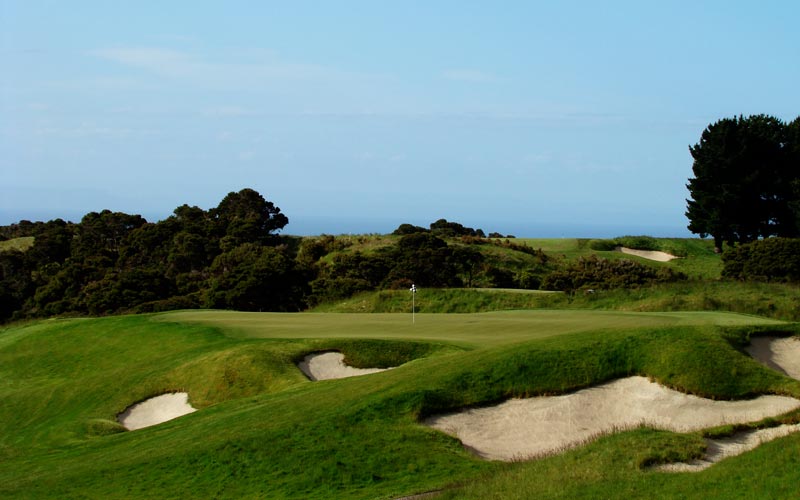
The bunkers in the foreground mask the large third green and its right to left tilt. At 9,800 square feet, it is one of the largest targets on the course.
Fourth hole, 585 yards, The Rise; A new tee just off the back left of the third green was added by Alex Robertson in 2008 and helps ensure that the hole plays as Tom Doak originally envisaged. With the addition of forty-five yards in length, the player now needs to find the power slot down the left of the sixty yard wide fairway as tee balls hit there enjoy up to fifty yards (!) more of roll as opposed to ones that hit into a hump that dominates the fairway’s right portion. Before the new tee was added, technology had advanced to the point where big hitters were indiscriminately getting their tee ball to tumble to the bottom of the fairway and were left with but a mid-iron into the green. Now, tee balls hit right hang back on the hill and golfers face a conundrum on what to do on their second shots. This is the height of great architecture off the tee: give all players a generous target but let the better player seek an advantage by properly shaping and placing his tee ball. Only by providing width can all levels of golfers enjoy a course, which is a lesson long taught by the Old Course at St. Andrews. Indeed, Alister MacKenzie (who is Tom Doak‘s favorite architect) incorporated this strategic design principle into his famous work at Augusta National and Royal Melbourne. Sadly, few architects did the same from 1948 through to 1988, so it is with relief and gratitude that architects like Tom Doak are once again embracing this design tenet. After all, golf in the great outdoors is meant to be fun and engaging, not grueling and discouraging.

Doak considers the blind tee shot at the fourth to be ‘one of the coolest tee shots I’ve ever built.’
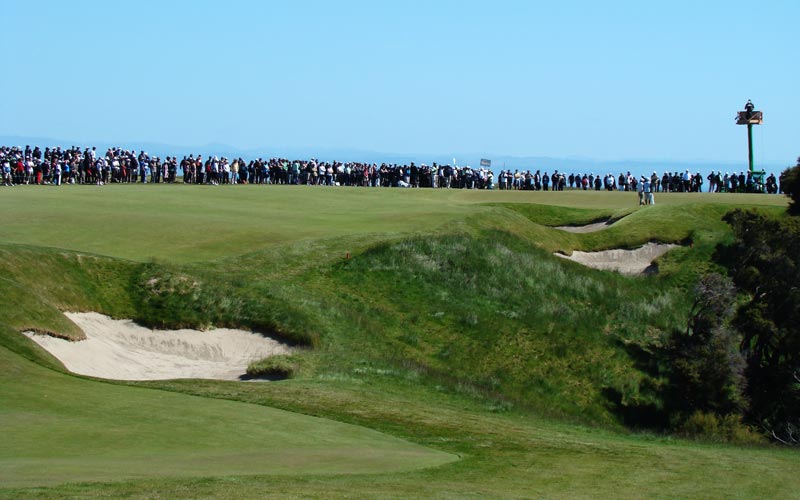
Fifth hole, 420 yards, Split; In general, the heaving ground contours combined with the fingers of land meant there wasn’t the need nor the opportunity for many central hazards. This hole is an exception and features a pair of bunkers in the middle of the fairway 150 yards from the green. Decisions abound. Go left to the widest part of the fairway or squeeze a tee shot into the narrower right portion of the fairway and enjoy the best angle into the green. As seen below, the flag flapping against the blue water in the distance is full of appeal but it took lowering the landform upon which the green is on by ten feet to create this visual. The fact that there is not one iota of evidence that any earthwork took place is credit to Tom Doak‘s talented team.
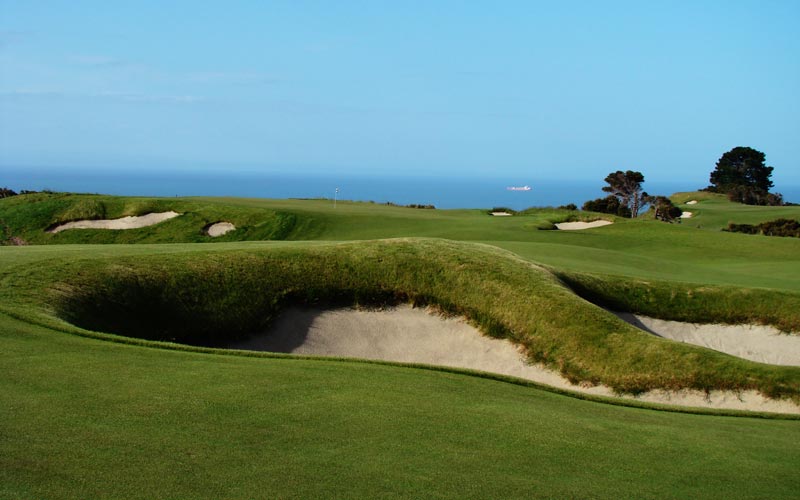
These two central hazards dictate play off the fifth tee. This is the first of four greens whereby Hawke’s Bay provides a stunning backdrop.
Sixth hole, 225 yards, Gulley; When routing a course over severe land, Tom Doak worries first about finding two and three shot holes as these holes require more land. He starts with an ideal green site and then works his way back: Is there a natural landing area from which to play one’s approach? If so, perhaps the hole will be a two shotter. If there is another landing area behind this one, then the hole may become a three shotter. Here at the sixth, there was a thrilling green site over a canyon but no logical place to put a fairway that wouldn’t require too much earth moving. Hence, it became a one shot hole and the only thing that keeps it from being better known in world golf is that comparably few golfers see it relative to Pebble Beach or Turnberry. According to Hepner, ‘the most impressive feature about Cape Kidnappers overall is how elegant the playing surface is compared to the surrounding ravines and cliffs. The scale of the property is so overstated, but the actual golfing ground is quite understated. The design is also very walkable with the only climbs being down to the bridge crossings. We intentionally kept the bridges low in the ravines so that they would not interfere with any long views of the property.’
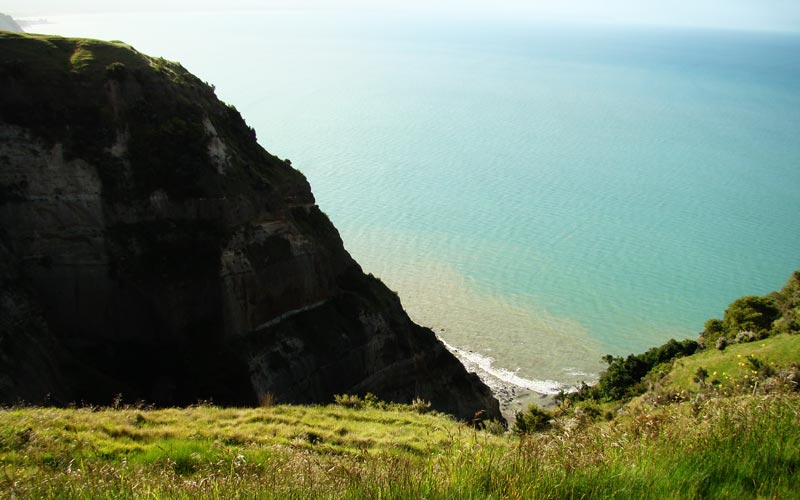
Deciding to place a green site beside this chasm made good sense and when no landing area could be found further back from it…
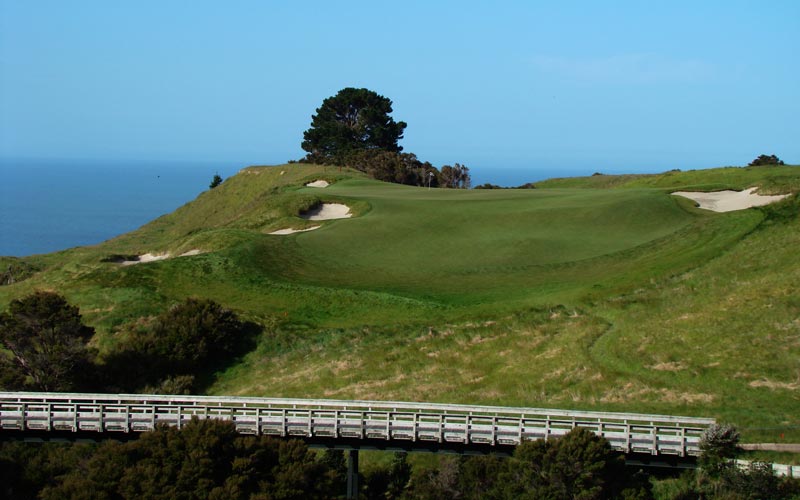
…a par three was created and sixth came into fruition. As distinct from some of the greens that feature subtle tilts, the sixth green is dramatically sweeps from right to left and helps gather balls toward the central and left hole locations.
Seventh hole, 455 yards, 14 Flags; Some people confuse minimalism for not moving dirt and that is inaccurate. Take this hole for instance whereby in its initial state, the last 100 yards of what became fairway was more of a canyon and the landform that became the green was more of a mountain. Dirt was pulled off the ‘mountain’ and into the canyon, making it less deep/steep. As seen by the first photograph in this course profile, standing at the crest of the fairway and looking down on the green complex is one of the most handsome views on the course, a tribute to the construction skill and talent that was brought to bear by Tom Doak‘s group. In a show of how diverse the holes can play depending on the wind, Camilo Villegas hit a drive 380 yards (!) on the first day of the 2009 Kiwi Challenge with his tee ball bounding down the hill and nearly finishing in the bottom of the gully just seventy-five yards from the back right hole location. His pitch was perfectly judged to five feet and the putt dropped for a well earned birdie. The following day, played into the wind, he guided a four iron through the wind from nearly two hundred yards away. In the span of twenty-four hours, his two well hit drives left him with two approach shots that were ~120 yards (!) different in length. When asked about it, he thought the hole played equally well both ways, a great compliment to the architect, and this kind of diversity leaves inland golf for dead relative to seaside golf.
Cape Kidnappers
Te Awanga, New Zealand
Eighth hole, 180 yards, Backstop; Given the ravines et al, the par three holes were always going to play an important part in having the routing flow seamlessly and it is no surprise that the course features five of them. Here is another case whereby a one shotter was used to cross a gully. Situated well away from the water, the eighth is not a mongrel like the twelfth at Pebble Beach whereby the golfer is just waiting to get back to the good stuff. Instead, it is another example of an inland hole that is full of charm and playing merit to the point where Doak considers it perhaps his favorite one shotter on the course.

The eighth enjoys a different feel from the other one shotters as it is situated on lower ground and is less exposed to the wind. The tee ball is played over low lying trees found in a gully. Note the slight depression just past the false front in the center of the green. There are lots of ways for balls to be gathered into it (and indeed it’s known as the hole in one location). Conversely, miss the bowl long and the golfer struggles to two putt.
Ninth hole, 405 yards, Dip; Not unlike the tenth at Shinnecock Hills, the golfer needs to make the decision from the tee how best to play the hole: Hit a driver over the crest of a hill and down into valley, leaving a sixty yard albiet blind pitch or lay back off the tee and have a full view of one of the best greens on the course but accept an approach from 140 yards. The hole functions great today and is another example of skillful dirt work as ten feet of earth was pulled off the front of the green and used to fill in and soften the valley below.

The ninth fairway tumbles downhill just past these two left side fairway bunkers. A tee ball near these bunkers leaves the golfer with an excellent view of the green and an approach shot of approximately 140 yards.

Tenth hole, 475 yards, Seaward Ho; Though the front is set across exhilarating land for golf, the back possesses the holes that golfers frequently see featured in aerial photographs as six of its holes are located along the famous ‘fingers’ of land that make Cape Kidnappers distinct from any site in world golf. The backdrops to the greens on the back nine changes from green to blue and the tenth is the first of three infinity greens.

The tenth hole heads away from the clubhouse and toward the water. The golfer salivates at the prospect of hitting a draw and watching the ball take the ground’s tilt and track toward back left hole locations.
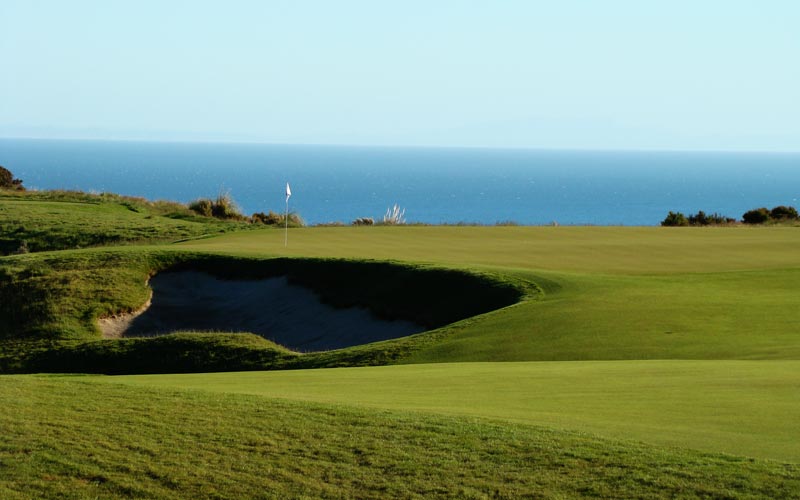
Note how the bunker was cut into the landform and is below the surface of the tenth green. According to Hepner, ‘ The bunkers were kept deep but quiet in nature to take advantage of the dark shadows cast at any time of the day. The sand lines were also kept in a low profile due to the occasional high wind days.’ In addition, another virtue of the bunker construction as presented here is that the golfer enjoys the pleasure of watching his ball slowly roll across the entire surface of the green.
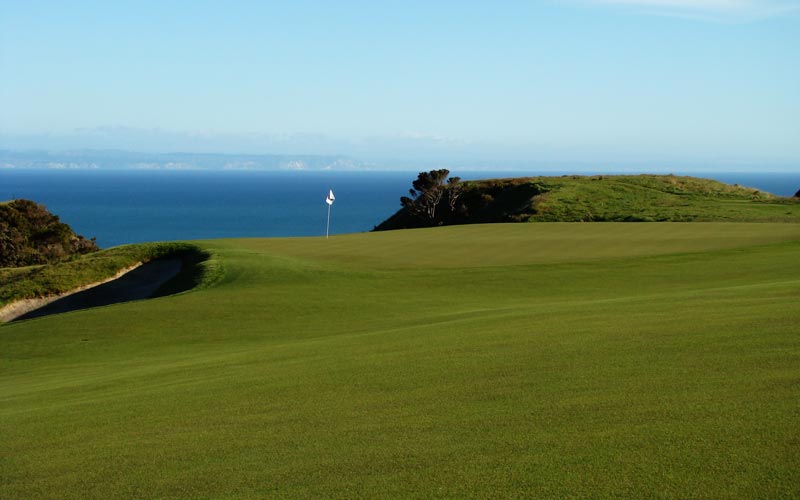
Eleventh hole, 225 yards, Look Out; As he heads back to the tee, the first time visitor might take comfort that this one shotter heads away from the cliffs, surmising that it might be a bit of a breather. Nothing could be farther from the truth as a chasm reaches within a few yards along the left of the green, which is little more than a knob with fall-offs short and right as well.
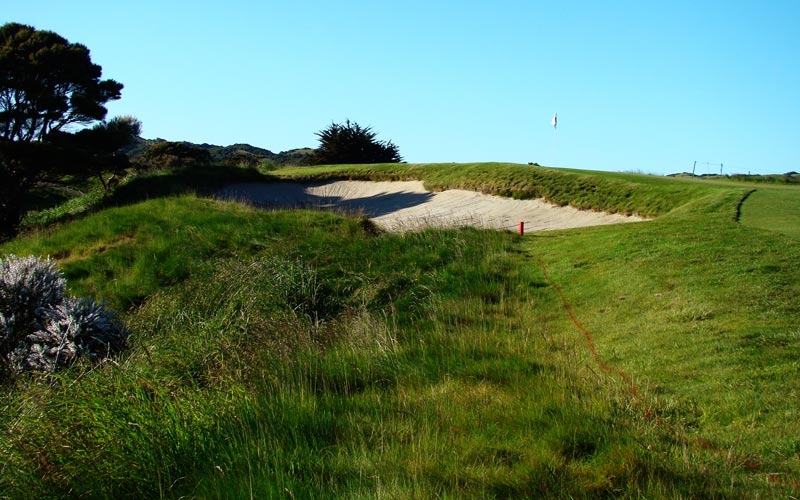
Twelfth hole, 460 yards, Infinity; Doak and Hepner use words like ‘understated’ and ‘elegant’ when describing their work at Cape Kidnappers and yet, such words seem at odds with a course whose holes are both thrilling and dramatic! A perfect example of how both sets of words can apply comes here at the bunkerless twelfth. Great time and effort was spent by Doak and his team in massaging the land before the green and the green itself so that the hole plays just right. Yet, this doesn’t mean that they added bunkers or other man-made hazards. Rather, the challenge rests in their subtle contouring of the land and the tight short grass. The green’s slope from front to back provides for expansive views of the water behind (put another way, if Doak had built up the back of the green so that it sloped in a traditional manner from back to front, much less of the Pacific would be in sight). Crucially, this is another example whereby the fast and firm conditions offered by Steve Marsden and his crew are central to allowing the hole to play properly. Some approach shots take ten plus seconds to trickle along the tilt of the green before finding back left hole locations and the hole wouldn’t be nearly as fun to play if that wasn’t the case. The end result of the design combined with the firm playing conditions is that the approach is another example whereby the playing merit is the equal to the striking setting. Doak summarizes it well when he says, ‘We were deliberately subtle with our architecture as there was no way in the world to compete with the surrounding beauty.’
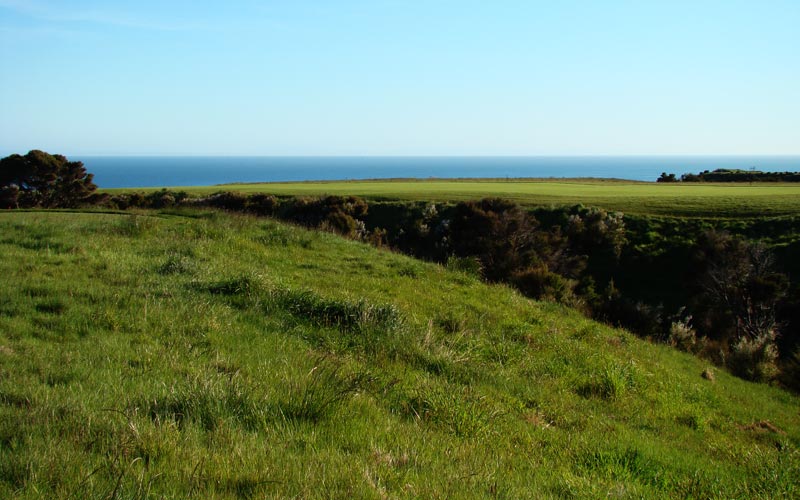
A new tee by Alex Robertson lends Cape playing characteristics to the tee ball, which now plays from the back markers on a diagonal over a ravine to a wide fairway that sweeps from right to left down toward the Pacific Ocean. Complicating matters is that the wind frequently blows from left to right, quartering against the golfer.
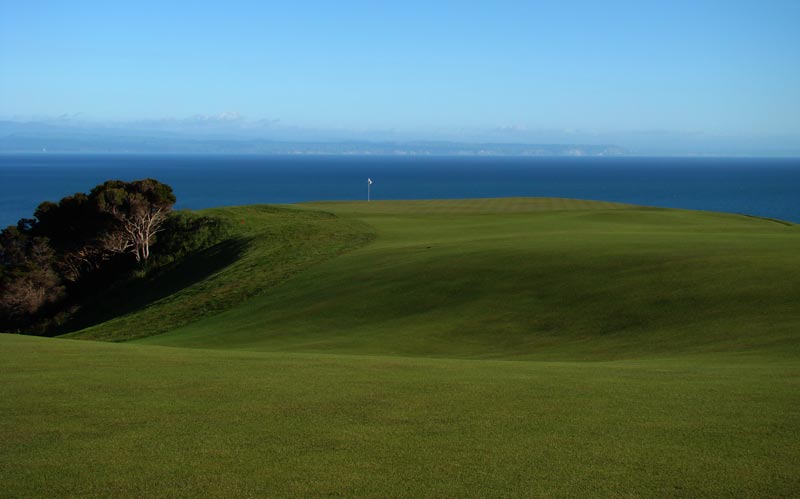
One of the game’s most enticing approach shots is this one to the twelfth green, which slopes from high front right to low back left. Judging how and where to land the ball is endlessly fascinating.
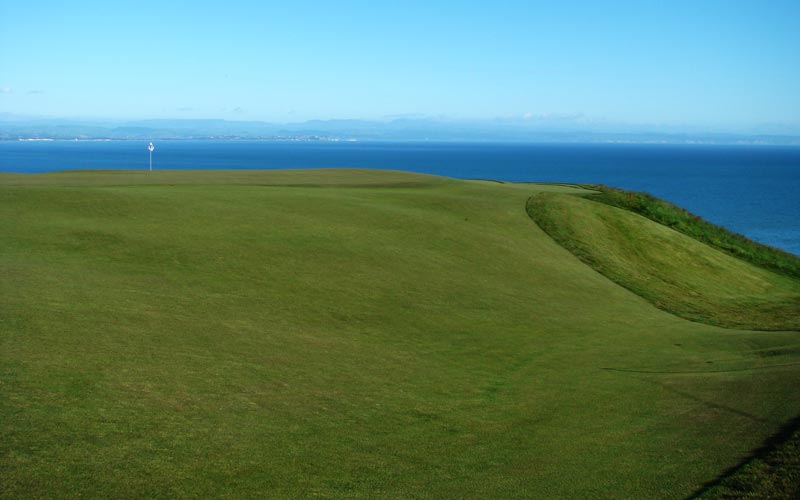
Of course, push it right and miss the tongue that feeds onto the green and the golfer is left with this difficult up and down to a green that runs away.
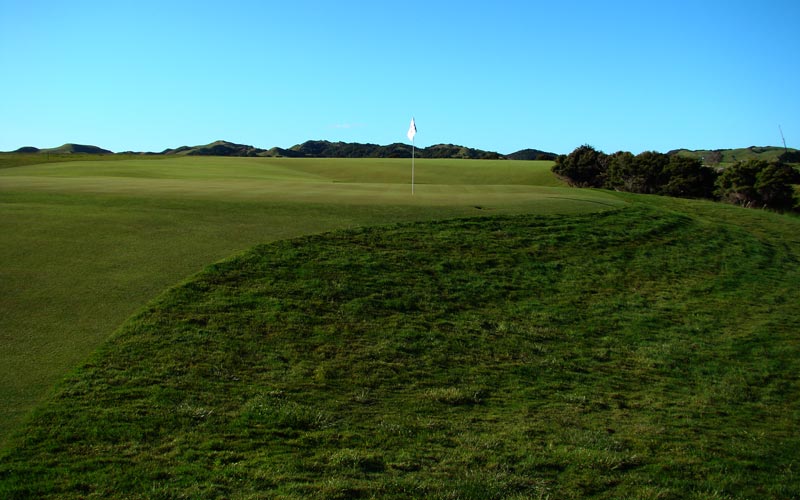
The golfer is frequently rewarded for playing bold, attacking golf at Cape Kidnappers. As this view from behind the twelfth green indicates, even if he is a bit aggressive with his approach shot, he has a chance to recover. Notice how much of the putting surface is in view from behind the green, a sure sign that the green slopes from front to back.
Thirteenth hole, 130 yards, Alex’s Ace; Though modest in length, none of the professionals in the 2009 Kiwi Challenge came close to a birdie either day. The domed green’s soft shoulders feed balls off all sides to the point where even accomplished golfers find the middle of the green to be a satisfactory result. As a result of the golf course construction slowdown caused by the events of September 11th, 2001, Doak’s most talented team members including Brian Schneider, Brian Slawnik and Eric Iverson all worked on this project and the result is evident in the graceful shaping that defines this green complex. Alex Robertson won’t discuss the hole’s name but his proud father is quick to point out that Alex had a hole in one here the day before the course officially opened by punching a low boring shot underneath the wind and into the hole for a tidy ‘one’.
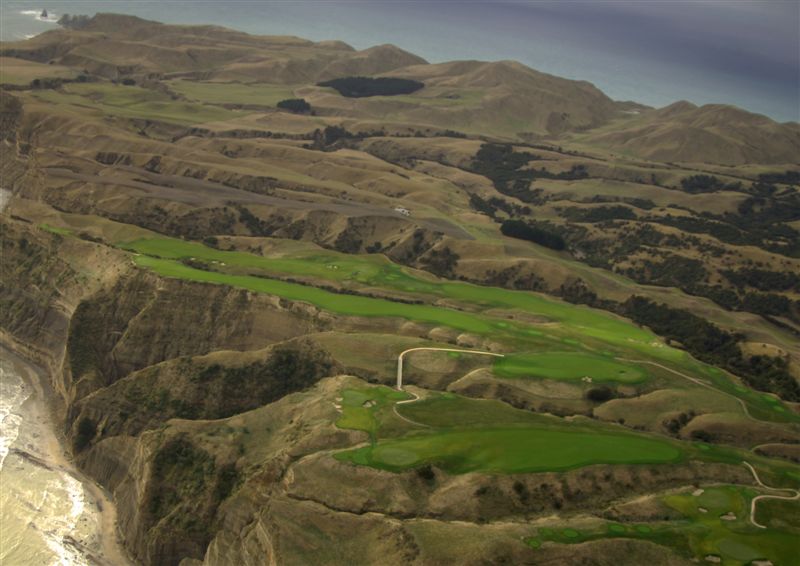
As seen in the bottom middle of Joann Dost’s aerial photograph, the long bunkerless twelfth takes the golfer back to the cliffs. With its tee behind the twelfth green, the thirteenth is the only hole on the course that plays in a southerly direction.
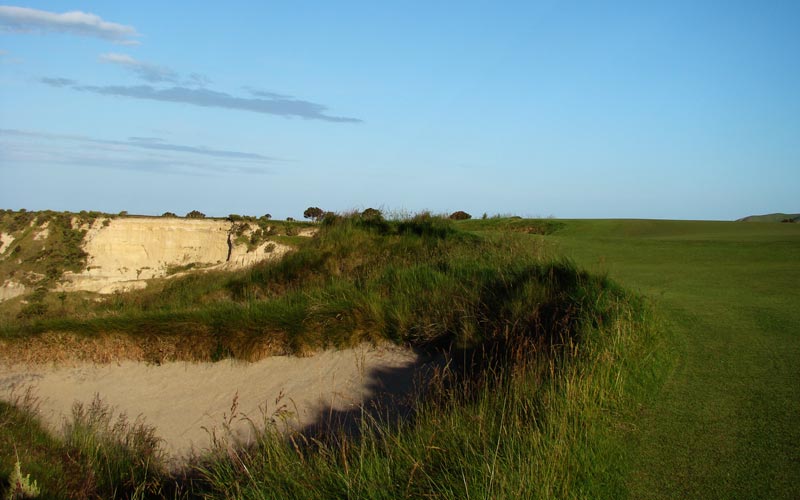
Most people are distracted by the 550 foot cliffs and deep bunkers down the left of the thirteenth but its putting surface provides the real challenge. Note how its front left slopes away and toward the bunkers.
Fourteenth hole, 350 yards, Pimple; Of all the variations on the Road Hole green complex, this may well be the best, coming as it does on a reachable par four hole. Downwind, long players can reach the green providing their skill is matched with the courage to drive it long down the side with the most trouble. Doak’s favorite courses like Crystal Downs, The Old Course at St. Andrews and Cypress Point have long shaped his affection for short par fours and this one is as good as any of them. Just as with the original at St. Andrews, to go over this green is doom as Adam Scott found to his chagrin during the 2008 Kiwi Challenge.

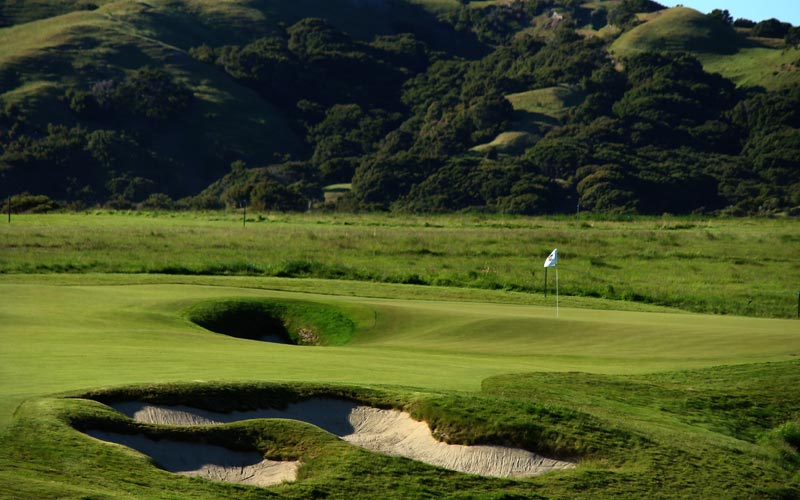
However, closer inspection shows that there are very distinct angles at play. Downwind, the tiger golfer entertains hope of his tee ball skirting the two bunkers sixty yards shy of the putting surface and running onto the green. At 4,600 square feet, this green is the smallest target on the course, which is fitting for a hole of its length.
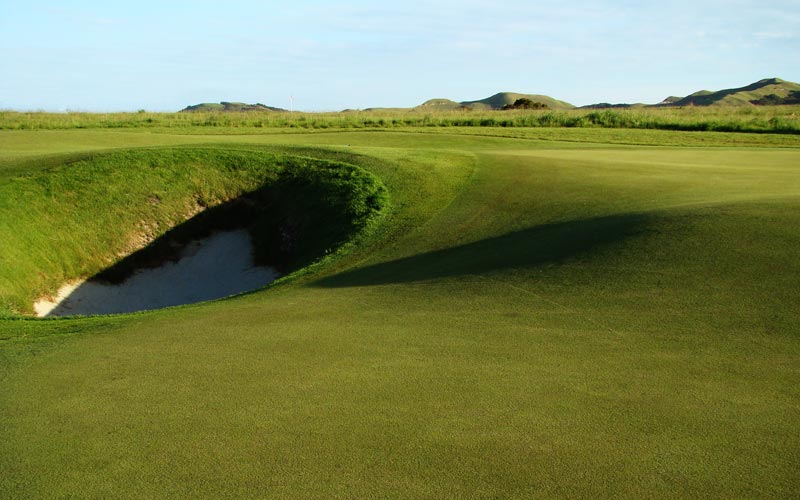
Cape Kidnappers
Te Awanga, New Zealand
Fifteenth hole, 655 yards, Pirate’s Plank; Sean O’Hair’s play in the 2009 Kiwi Challenge is emblematic of the enormous flexibility that Doak built into the holes so that they play equally well whether into or downwind. In Tuesday’s round, O’Hair hit a five iron that ran for seventy yards (!) and finished just over the green in two in near down gale conditions. On Wednesday, playing into a breeze, he made two double bogeys and lost the championship to Anthony Kim. The fifteenth has no bunkers from tee to green and doesn’t need any as the finger of land that it occupies progressively narrows the closer one gets to the green. Rarely does a flat hole yield a horizon green but this one does, making depth perception a challenge. At this height, the immensity and silence of the Pacific Ocean is more unnerving than it is comforting and it is all the golfer can do to keep his wits about him. As Doak succinctly puts it, ‘We were either going to build it or not build it – there weren’t a lot of options on this, the narrowest of fingers.’ This is Mr. Robertson’s favorite hole, which explains why it was used to decide the play-off for the 2009 Kiwi Challenge. The ensuing television coverage as well as its own playing merits conspire to make this the most famous hole that Doak has designed to date. Indeed, how ironic for an architect that stresses fun and variety to have the longest hole in New Zealand become his most noted creation!

Even the most well traveled golfer struggles to maintain his concentration and not be over-awed as he plays down the fifteenth. This golfer’s long approach shot was fortunate to find the left greenside bunker is it is easier to recover from than the shore 550 feet below!
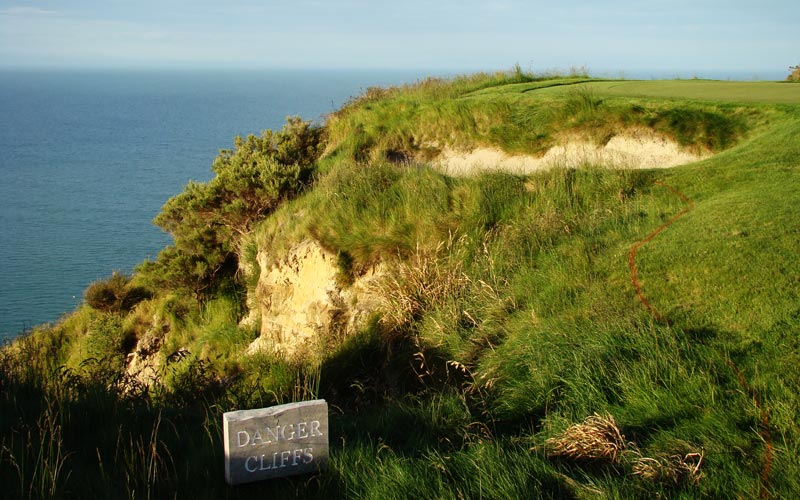
This sign twelve yards to the left of the fifteenth green is no exaggeration. As seen below, the green was …

Looking back down the fairway, one gains a sense of its ever narrowing nature and why the hole is aptly named Pirate’s Plank. The white posts of the fence are there for very good reason: the golf expression ‘it’s death to go over’ has no better use than here.
Sixteenth hole, 500 yards, Widow’s Walk; The hole’s name refers to the 120 yard walk along the top of a dune line from the fifteenth green to the sixteenth tee, featuring a steep drop off all along the left. The elevated tee is the single most exposed point on the course and as such, anything can happen. On a day when the wind is behind, the tee is one of the prettiest spots in world golf. On a day when the wind is fiercely against, it is one of the loneliest! Full credit goes to Mr. Robertson’s wife Josie for this tee. Originally, the fifteenth green stopped fifty yards short of where it presently does and the sixteenth was to play as a par four hole from a tee that would roughly have been located to the right of where the fifteenth green resides today. Mr. Robertson thought it better still if the fifteenth green was moved back fifty yards and built up against the cliff and that meant finding a new tee for the sixteenth. Once Doak located it, Mr. Robertson signed off but it was Josie who said what a pity that only players who played from the elevated championship tee would get to experience it. From that moment on, the sixteenth went from being a par four to a par five as all the tees were brought up to this magnificent location. Crucially, the hole plays in the exact opposite direction as the fifteenth, so the two holes are guaranteed to play wildly different.

The view from the elevated tee box shows a hole of great beauty. If the fifteenth was a beast and played into the wind, the sixteenth might well be reachable with as little as a mid-iron.
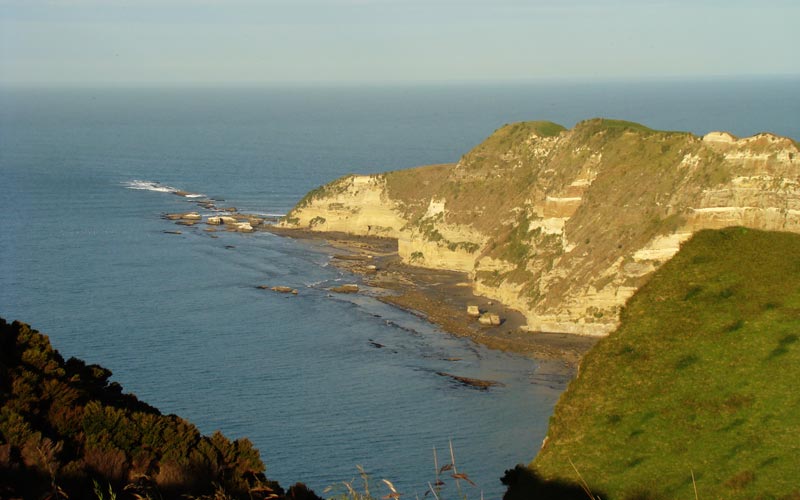
Even at this late point in the round, the golfer has yet to become accustomed to the scale of his surrounds and this view back off the sixteenth tee of Black Reef still takes his breath away.

What a spot to play from! Anthony Kim hits one long right off the sixteenth tee in the final round of the 2009 Kiwi Challenge.

Cliffside courses rarely possess as interesting fairway contours as true links courses. Such is not the case at Cape Kidnappers as its fairways are full of character, as seen above from 150 yards short of the sixteenth green.
Seventeenth hole, 465 yards, Gannets Perch; Several years ago, Sports Illustrated featured an article comparing Cape Kidnappers to Pebble Beach and compared the holes to one another in match play format, first hole to first hole, second to second, etc. Cape Kidnappers was two up with three to go and the writer awarded the last three to Pebble to give it a narrow, come from behind one up victory. The shock of the exercise was that Pebble was awarded this hole as the seventeenth at Cape Kidnappers is fantastically conceived. Doak modestly says it was an easy hole to find on a topography map as the golfer plays to one level before stepping up to the next but that doesn’t change the fact that this dogleg right is a thorough original.
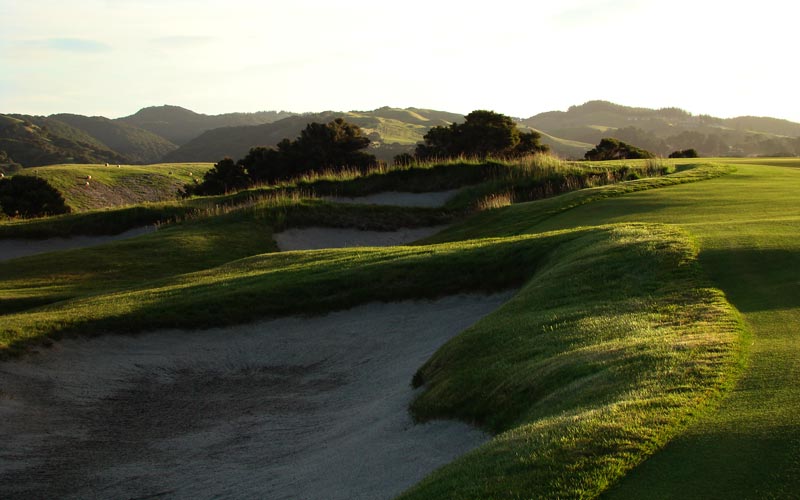
This cluster of greenside bunkers must be contended with on one’s uphill approach to the seventeenth green. The bunkers are ideally presented as neat and clean ones would be out of whack with their surrounds.
Eighteenth hole, 475 yards, Ipu; The most controversial feature on the course has nothing to do with its dramatic setting along 550 foot cliffs or interior putting contours that are too wild to function properly. Rather, the most controversial feature is that Doak elected to set the Home green within a natural depression, thus giving it punchbowl qualities. Some critics as far away as the United Kingdom have singled it out as the course’s only weakness, arguing that as a finishing hole, it should require precise shot making skills. They sniff that too many approach shots end up in nearly the same area, regardless of the quality of the hit or thought that went into the shot. That’s one side, now let’s hear Doak’s opinion on the intricacies of this green complex: ‘The green site for the 18th was a beautiful little dip in the ground very close to the clubhouse site. I fell in love with this green site right away, and thought it made a perfect contrast to the raised and heavily defended greens at the 16th & 17th holes. My thought was that having a bowl green site for #18 added variety to the course, but as Julian became more interested in hosting a professional event, he began to worry that the hole would be too easy, and that someone might win because they hit a fluke shot to the left that wound up close to the hole. We took this into account and if the hole is cut along the left half of the green, a shot which bounces in from left to right careens way past the hole; Michael Campbell confirmed as much to Julian after a visit and assured him that only a great approach shot could get close to certain hole locations. Interestingly enough, in the two years of the Kiwi Challenge they’ve never actually used the left hole locations we discussed, because the TV producers think the hole looks better with the flag at the back of the green! Even so, there’s been only one birdie out of the twelve cracks that the professionals have had at the hole.’ In addition, the Old Course at St. Andrews has long demonstrated the appeal of having a chance for birdie on the Home hole so that the golfer ends his round on a positive note. As there, the first tee is only forty yards away so let’s keep playing!

Having concluded the round, the golfer may desire a flat white or a Steinlager in the farm-style clubhouse, which is the only structure on the 280 acres that the course occupies. In fact, given that the course is cocooned in amongst the rest of the 6,000 plus acres of Cape Kidnappers, the golfer starts to appreciate that he didn’t hear a single sound from the outside world during his round. Literally, the baahing sheep may have been the only noise to distract him from the task at hand. What an enormous luxury to play golf in such an environment.
The Farm at Cape Kidnappers is the main lodge and is located one mile away, on a higher portion of the property with commanding views across the rolling grounds and out to the ocean. All guests need to avail themselves of the opportunity to go on a gannet safari as nowhere are these graceful birds more accessible than here at Cape Kidnappers. The spa, tour of the farm or even going off property for a wine tour needs to wait until after these birds are seen up-close. For this is the reason that one comes here: to do and experience things that that can only be found in this part of the world. And as that relates to golf, Cape Kidnappers will remind you of no other course and the only thing for sure is that you will want to come back.
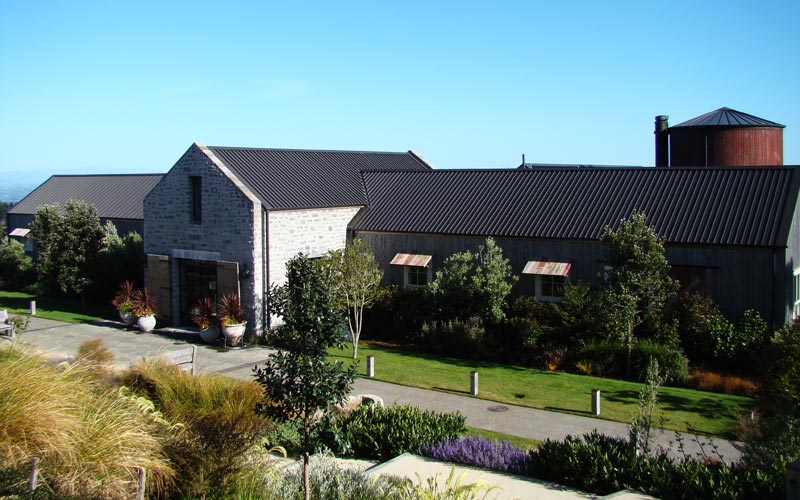
The Lodge was designed to resemble farm buildings (note the silo structure) and Josie Robertson’s taste brings the interior to live.

In some circles, Cape Kidnappers is better known for having the largest gannet colony in the world. Guests of the Farm would be remiss not to see these lithesome birds as they dive into the ocean for fish. In addition, a tour of the gannet colony provides some…

…some of the best vantage points for The Pinnacle at the tip of Cape Kidnappers.
The End





